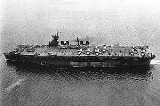
Independence class aircraft carrier
Encyclopedia
The Independence class aircraft carriers were a class of light carriers
built for the United States Navy
that served during World War II.
This class were a result of President Franklin D. Roosevelt's interest in Navy shipbuilding plans. In August 1941, with war looming, he noted that no new fleet aircraft carriers
were expected before 1944 and proposed to quickly convert some of the many cruiser
s then under construction. Studies of cruiser-size aircraft carriers had shown their serious limitations, with the General Board of the United States Navy
replying that such a conversion showed too many compromises to be effective on Oct 13th 1941. The President ordered another study on Oct 25th and BuShips replying that the cruiser conversion would result in a lesser capability but would be available sooner. The crisis following the December 1941 Pearl Harbor attack
demonstrated the urgent need for more carriers as soon as possible. The Navy responded by greatly accelerating construction of the big Essex class aircraft carrier
s and, in January 1942, reordering a Cleveland class light cruiser as an aircraft carrier.
Plans developed for this conversion showed much more promise than expected. The design being based on the Sangamon class escort carrier
and two more light cruiser
s were reordered as carriers in February, three in March and a final three in June 1942. Completed in January–December 1943, simultaneously with the first eight Essexes, the nine Independence class ships were vital components of the great offensive that tore through the central and western Pacific from November 1943 through August 1945. Eight of them participated in the June 1944 Battle of the Philippine Sea
, which effectively eliminated Japan's carrier air power, supplying 40 percent of the fighters and 36 percent of the torpedo bombers.
The Independence class design featured a relatively short and narrow flight deck and hangar, with a small island. To compensate for this additional topside weight, blisters were added to the original cruiser hull, which increased the original beam by five feet. The typical air group, originally intended to include nine each of fighters, scout-bombers and torpedo planes, was soon reoriented to number about two dozen fighters and nine torpedo planes.
These were limited-capability ships, whose principal virtue was near-term availability, and the speed necessary to operate in the fleet-carrier task groups. Their small size made for seakeeping problems and a relatively high aircraft accident rate. Protection was modest and many munitions had to be stowed at the hangar level, a factor that contributed greatly to the loss of Princeton in October 1944.
 There was little margin for growth, as the ships' post-war careers showed. Independence was expended as an atomic bomb target, and the rest were laid up in 1947. Five returned to service in 1948–53, two with the French Navy. Two were used as training carriers, while Bataan saw Korean War combat duty with Marine Corps air groups. She and Cabot received anti-submarine warfare modernisations in the early 1950s, emerging with two funnels
There was little margin for growth, as the ships' post-war careers showed. Independence was expended as an atomic bomb target, and the rest were laid up in 1947. Five returned to service in 1948–53, two with the French Navy. Two were used as training carriers, while Bataan saw Korean War combat duty with Marine Corps air groups. She and Cabot received anti-submarine warfare modernisations in the early 1950s, emerging with two funnels
instead of the original four. All but the French ships were decommissioned in 1954–56 and were reclassified as aircraft transports in 1959. Cabot got a new lease on life in 1967, when she became the Spanish Navy's carrier Dedalo
, serving until 1989 (in Spanish service, she was the first carrier to regularly deploy the Harrier jump jet). Despite best efforts to preserve her, Cabot was scrapped at Brownsville, TX starting in 1999 and ending in 2003. Preservation efforts continued until the hull was half scrapped.
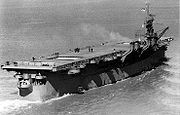
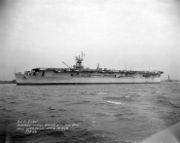
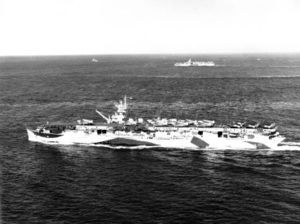
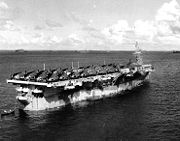 The nine ships of the Independence-class were all converted from Cleveland-class light cruisers building at the New York Shipbuilding
The nine ships of the Independence-class were all converted from Cleveland-class light cruisers building at the New York Shipbuilding
Corporation shipyard, Camden, New Jersey. Initially classified as "aircraft carriers" (CV), all were re-designated "small aircraft carriers" (CVL) on 15 July 1943, while four ships were still under construction.
Light aircraft carrier
A light aircraft carrier is an aircraft carrier that is smaller than the standard carriers of a navy. The precise definition of the type varies by country; light carriers typically have a complement of aircraft only ½ to ⅔ the size of a full-sized or "fleet" carrier.-History:In World War II, the...
built for the United States Navy
United States Navy
The United States Navy is the naval warfare service branch of the United States Armed Forces and one of the seven uniformed services of the United States. The U.S. Navy is the largest in the world; its battle fleet tonnage is greater than that of the next 13 largest navies combined. The U.S...
that served during World War II.
This class were a result of President Franklin D. Roosevelt's interest in Navy shipbuilding plans. In August 1941, with war looming, he noted that no new fleet aircraft carriers
Aircraft carrier
An aircraft carrier is a warship designed with a primary mission of deploying and recovering aircraft, acting as a seagoing airbase. Aircraft carriers thus allow a naval force to project air power worldwide without having to depend on local bases for staging aircraft operations...
were expected before 1944 and proposed to quickly convert some of the many cruiser
Cruiser
A cruiser is a type of warship. The term has been in use for several hundreds of years, and has had different meanings throughout this period...
s then under construction. Studies of cruiser-size aircraft carriers had shown their serious limitations, with the General Board of the United States Navy
General Board of the United States Navy
The General Board of the United States Navy was an advisory body of the United States Navy, effectively a naval general staff. The General Board was established by general order 544, issued on March 13, 1900 by John Davis Long. The order was officially recognized by Congress in 1916...
replying that such a conversion showed too many compromises to be effective on Oct 13th 1941. The President ordered another study on Oct 25th and BuShips replying that the cruiser conversion would result in a lesser capability but would be available sooner. The crisis following the December 1941 Pearl Harbor attack
Attack on Pearl Harbor
The attack on Pearl Harbor was a surprise military strike conducted by the Imperial Japanese Navy against the United States naval base at Pearl Harbor, Hawaii, on the morning of December 7, 1941...
demonstrated the urgent need for more carriers as soon as possible. The Navy responded by greatly accelerating construction of the big Essex class aircraft carrier
Essex class aircraft carrier
The Essex class was a class of aircraft carriers of the United States Navy, which constituted the 20th century's most numerous class of capital ships with 24 vessels built in both "short-hull" and "long-hull" versions. Thirty-two were originally ordered; however as World War II wound down, six were...
s and, in January 1942, reordering a Cleveland class light cruiser as an aircraft carrier.
Plans developed for this conversion showed much more promise than expected. The design being based on the Sangamon class escort carrier
Sangamon class escort carrier
The Sangamon class were a group of four escort aircraft carriers of the United States Navy that served during World War II.-Overview:These ships were originally MARAD type T3-S2-A1 oilers, launched in 1939 for civilian use. They were acquired and commissioned by the U.S. Navy in 1940-41...
and two more light cruiser
Light cruiser
A light cruiser is a type of small- or medium-sized warship. The term is a shortening of the phrase "light armored cruiser", describing a small ship that carried armor in the same way as an armored cruiser: a protective belt and deck...
s were reordered as carriers in February, three in March and a final three in June 1942. Completed in January–December 1943, simultaneously with the first eight Essexes, the nine Independence class ships were vital components of the great offensive that tore through the central and western Pacific from November 1943 through August 1945. Eight of them participated in the June 1944 Battle of the Philippine Sea
Battle of the Philippine Sea
The Battle of the Philippine Sea was a decisive naval battle of World War II which effectively eliminated the Imperial Japanese Navy's ability to conduct large-scale carrier actions. It took place during the United States' amphibious invasion of the Mariana Islands during the Pacific War...
, which effectively eliminated Japan's carrier air power, supplying 40 percent of the fighters and 36 percent of the torpedo bombers.
The Independence class design featured a relatively short and narrow flight deck and hangar, with a small island. To compensate for this additional topside weight, blisters were added to the original cruiser hull, which increased the original beam by five feet. The typical air group, originally intended to include nine each of fighters, scout-bombers and torpedo planes, was soon reoriented to number about two dozen fighters and nine torpedo planes.
These were limited-capability ships, whose principal virtue was near-term availability, and the speed necessary to operate in the fleet-carrier task groups. Their small size made for seakeeping problems and a relatively high aircraft accident rate. Protection was modest and many munitions had to be stowed at the hangar level, a factor that contributed greatly to the loss of Princeton in October 1944.
Disposal

Funnel (ship)
A funnel is the smokestack or chimney on a ship used to expel boiler steam and smoke or engine exhaust. They can also be known in as stacks.-Purpose:...
instead of the original four. All but the French ships were decommissioned in 1954–56 and were reclassified as aircraft transports in 1959. Cabot got a new lease on life in 1967, when she became the Spanish Navy's carrier Dedalo
Spanish aircraft carrier Dédalo
Dédalo was the first Spanish aircraft carrier and the second aviation ship in the Spanish Navy . She remained the fleet's flagship until the Principe de Asturias replaced her...
, serving until 1989 (in Spanish service, she was the first carrier to regularly deploy the Harrier jump jet). Despite best efforts to preserve her, Cabot was scrapped at Brownsville, TX starting in 1999 and ending in 2003. Preservation efforts continued until the hull was half scrapped.
Ships in class




New York Shipbuilding
The New York Shipbuilding Corporation was founded in 1899 and opened its first shipyard in 1900. Located in Camden, New Jersey on the east shore of the Delaware River, New York Ship built more than 500 vessels for the U.S...
Corporation shipyard, Camden, New Jersey. Initially classified as "aircraft carriers" (CV), all were re-designated "small aircraft carriers" (CVL) on 15 July 1943, while four ships were still under construction.
- Independence (CV/CVL-22)USS Independence (CVL-22)The fourth USS Independence was a United States Navy light aircraft carrier, lead ship of her class.-Construction and deployment:...
. Keel laid in May 1941 as Amsterdam (CL-59); reclassified as an aircraft carrier in January 1942; launched in August 1942; commissioned in January 1943. Postwar, she was surplus to the Navy's requirements and expended in Operation CrossroadsOperation CrossroadsOperation Crossroads was a series of nuclear weapon tests conducted by the United States at Bikini Atoll in mid-1946. It was the first test of a nuclear weapon after the Trinity nuclear test in July 1945...
in July 1946, but survived both tests with little damage. She was used as a radiation research hulk for several years afterward and expended as a target in January 1951. - Princeton (CV/CVL-23)USS Princeton (CVL-23)The fourth USS Princeton was a United States Navy lost at the battle of Leyte Gulf in 1944.-Construction and deployment:The ship was laid down as the Tallahassee by the New York Shipbuilding Corporation, Camden, New Jersey, 2 June 1941...
. Keel laid in June 1941 as Tallahassee (CL-61); reclassified as an aircraft carrier in February 1942; launched in October 1942; commissioned in February 1943. Destroyed as a result of Japanese air attack 24 October 1944 during Battle of Leyte GulfBattle of Leyte GulfThe Battle of Leyte Gulf, also called the "Battles for Leyte Gulf", and formerly known as the "Second Battle of the Philippine Sea", is generally considered to be the largest naval battle of World War II and, by some criteria, possibly the largest naval battle in history.It was fought in waters...
. - Belleau Wood (CV/CVL-24)USS Belleau Wood (CVL-24)USS Belleau Wood was a United States Navy active during World War II in the Pacific Theater, from 1943 to 1945. The ship also served in the First Indochina War under French Navy temporary service as Bois Belleau....
. Keel laid in August 1941 as New Haven (CL-76); reclassified as an aircraft carrier in February 1942; launched in December 1942; commissioned in March 1943. Decommissioned to reserve in January, 1947. Transferred to French Navy as Bois Belleau (R97) 6/51. Returned to the US Navy for scrapping 9/60. - Cowpens (CV/CVL-25)USS Cowpens (CVL-25)USS Cowpens , nicknamed The Mighty Moo, was an 11,000-ton that served the United States Navy from 1943 to 1947....
. Keel laid in November 1941 as Huntington (CL-77); reclassified as an aircraft carrier in March 1942; launched in January 1943; commissioned in May 1943. Decommissioned to reserve in January, 1947. Stricken and scrapped starting November 1959. - Monterey (CV/CVL-26)USS Monterey (CVL-26)USS Monterey was an Independence-class light aircraft carrier of the United States Navy, in service during World War II and used in training for several years thereafter....
. Keel laid in December 1941 as Dayton (CL-78); reclassified as an aircraft carrier in March 1942; launched in February 1943; commissioned in June 1943. Decommissioned to reserve February 1947. Recommissioned as training carrier September 1950, decommissioned to reserve again January 1956. Re-designated aircraft transport AVT-2 May 1959. Stricken June 1970.. Originally planned as Fargo (CL-85); reclassified as an aircraft carrier in March 1942; keel laid in April 1942; name changed from Crown Point to Langley in November 1942; launched in May 1943; commissioned in August 1943. Decommissioned to reserve February 1947. Transferred to France as La Fayette (R96)La Fayette (R96)The La Fayette was an 11,000-ton that served French Navy as the from 1951 to 1963. She was the first French vessel named after the 18th century general Marquis de Lafayette...
2 June 1951. Returned to USN and stricken March 1963, scrapped at Baltimore in 1964.. Keel laid in March 1942 as Wilmington (CL-79); reclassified as an aircraft carrier in June 1942; launched in April 1943; commissioned in July 1943. Decommissioned to reserve February 1947, recommissioned and modernised as ASW carrier October 1948. Decommissioned to reserve January 1955, modernised 1965-7 and transferred to Spain as DedaloSpanish aircraft carrier DédaloDédalo was the first Spanish aircraft carrier and the second aviation ship in the Spanish Navy . She remained the fleet's flagship until the Principe de Asturias replaced her...
(R01) 30 August 1967. Stricken from NVRNaval Vessel RegisterThe Naval Vessel Register is the official inventory of ships and service craft in custody of or titled by the United States Navy. It contains information on ships and service craft that make up the official inventory of the Navy from the time a vessel is authorized through its life cycle and...
and sold to Spain August 1972. Decommissioned for preservation at New Orleans August 1989, preservation efforts failed. Scrapped at Brownsville, TexasBrownsville, TexasBrownsville is a city in the southernmost tip of the state of Texas, in the United States. It is located on the northern bank of the Rio Grande, directly north and across the border from Matamoros, Tamaulipas, Mexico. Brownsville is the 16th largest city in the state of Texas with a population of...
starting October 2000.. Originally planned as Buffalo (CL-99); reclassified as an aircraft carrier in June 1942; keel laid in August 1942; launched in August 1943; commissioned in November 1943. Decommissioned to reserve February 1947, recommissioned and modernised as ASW carrier May 1950. Decommissioned to reserve April 1954. Stricken for scrapping September 1959.. Originally planned as Newark (CL-100); reclassified as an aircraft carrier in June 1942; keel laid in October 1942; name changed from ReprisalUSS ReprisalTwo ships of the United States Navy have borne the name USS Reprisal, promising hostile action in response to an offense. was a brig purchased by the American Continental Congress to serve in the American Revolutionary War. was to be an , converted from the light cruiser . The Reprisal was...
to San Jacinto in January 1943; launched in September 1943; commissioned in December 1943. Decommissioned to reserve March 1947. Stricken June 1970.

